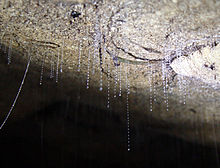Longhorn mosquitoes
| Longhorn mosquitoes | ||||||||||
|---|---|---|---|---|---|---|---|---|---|---|

Macrocera pusilla |
||||||||||
| Systematics | ||||||||||
|
||||||||||
| Scientific name | ||||||||||
| Keroplatidae | ||||||||||
| Rondani , 1856 |
The longhorn mosquitoes (Keroplatidae, synonym Macroceridae) are a family of the two-winged birds (Diptera) and belong to the mosquitoes (Nematocera). The types of the family are common worldwide.
features
Adults
They are mostly small mosquitoes. The adults have long, curved, 16-parted antennae , to which they owe their German-language name, based on the Longhorn cattle . In the subfamily Macrocerinae , the antennae often reach body length or even go beyond it. In several species such as Arachnocampa luminosa and Keroplatus testaceus from the subfamily Keroplatinae , both the larvae and the adult mosquitoes show luminescence .
Larvae
The larvae are slender and have a rich secondary structure, which blurs the actual segment boundaries. The head capsule is fully developed, as is the tracheal system . However, the openings of the trachea, the spiracles , are closed and oxygen is absorbed through the skin (skin breathing). The yellowish fat bodies in the back of the body are striking. The larvae live under stones, leaves, bark, in tree stumps and under webs. When disturbed, they curl up and feed on small animal corpses ( necrophagy ) and fungal threads .
Systematics
There are around 1000 species in this group of animals worldwide. The subfamilies Macrocerinae and Keroplatinae are particularly rich in species . The Macrocerinae were often considered to be a separate family Macroceridae. The subfamilies and their tribes:
Individual evidence
- ↑ Neal L. Evenhuist: Catalog of the Keroplatidae of the World (Insecta: Diptera) . Bishop Museum Bulletin in Entomology 13, Bishop Museum Press, Honolulu 2006
literature
- K. Honomichl, Heiko Bellmann: Biology and ecology of insects . CD-Rom, Gustav Fischer Verlag, Stuttgart 1994.
